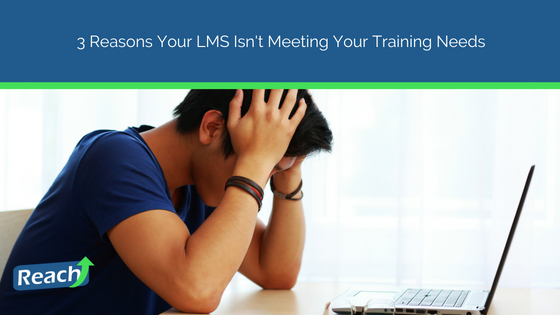3 Reasons Your LMS Isn’t Meeting Your Training Needs

When the first learning management system (LMS) was created, it was designed to serve as a teacher’s aide – a sort of informational repository that educators could use to keep their lessons and materials organized.
Over time, the LMS was expanded upon, and it became a tool that both teachers and students could use to produce better educational outcomes. Students were able to access learning materials from any computer, and teachers were able to spend less time printing hard copy lessons or organizing large amounts of paper.
It was a revolutionary solution for many issues that educators and employers faced when offering training to their staff members or students.
By the time a cloud-based learning management system was introduced in 2008, many employers and educational institutes were utilizing an LMS as part of their training process or curriculum.
In fact, 46 percent of respondents to the Global State of Digital Learning survey report having a learning management system.
But since the introduction and subsequent rise of the smartphone, the learning industry has once again gone through a major transformation. Suddenly, it was no longer good enough to have a computer-based LMS. Students and employees became accustomed to accessing information on-the-go from wherever they were, all via their mobile device.
This shift created a major disruption in the eLearning industry, forcing educational institutions and corporations to evaluate their training procedures.
In this blog, we’ll be covering the greatest hurdles that traditional learning management systems face, and the top reasons why business owners are making the leap from LMS to mLearning – a transition that many companies are predicted to make in the near future.
Let’s get to it!
HERE ARE THE THREE REASONS YOUR LMS ISN’T MEETING YOUR COMPANY TRAINING NEEDS:
- THE PLATFORM LOOKS AND FEELS DATED
While traditional learning management systems certainly addressed a need during their peak, they have struggled to keep up with modern day technology, especially when it comes to design.
Unlike many of the mLearning apps available today, learning management systems struggle to handle large amounts of video content, and most aren’t designed with gamification in mind.
Overall, most LMS options are built with a more formal structure, making them look and feel more like a traditional computer program rather than an innovative and engaging app. Courses are typically longer and structured the way they would be in a traditional classroom setting. This can make it tiresome to consume LMS content.
With a learning platform, that incorporates game-based learning, however, lessons can be broken down into smaller modules that are easier to digest.
It’s also possible to gamify the learning experience with a serious learning game framework. In contrast to entry-level gamification, serious games act as the educational platform and promote learning objectives through different game elements. These can include game-specific resources, simulations designed to mimic real-life situations, and reward systems to unlock new lessons.
If you want your learners to enjoy learning new skills, a traditional LMS may be hindering your efforts more than it’s helping them.
- THE LACK OF ACCESSIBILITY IS LIMITING HOW OFTEN YOUR EMPLOYEES USE THE PLATFORM
Would your employees log into your training platform more frequently if they could access it from their mobile device at any time of day?
This is a question every business owner should consider.
In today’s society, people carry their phones with them almost everywhere they go. Whether it’s while they are taking their lunch break, during the bus ride home from the office, or as they lay on their couch in the evening… there are plenty of opportunities for mobile engagement you could be missing if you’re still using an LMS.
Most learning management systems are still restricted to laptops and desktops only. And the few systems that can be accessed via a mobile device don’t function the same way a hybrid learning platform would, since they aren’t built from the ground up for mobile use.
If you want your employees to enjoy a seamless, engaging mobile experience, a game-based learning app is the ideal choice.
- YOUR LMS ISN’T OPTIMIZED TO ACHIEVE HIGH RETENTION RATES
One of the most amazing benefits of gamification for learning purposes is that it has been proven to increase retention rates amongst learners.
In fact, a study at Indiana University found that game-based learning increased retention by more than 300 percent in immediate post-testing, and by as much as 10 times when subjects were tested six weeks later.
That’s an incredible improvement, by any standard.
At Reach, our apps are specifically and intentionally designed to incorporate the latest serious gaming techniques, improving the likelihood that your learners will benefit from higher engagement and retention rates.
Unfortunately, most LMS options are not built with gamification in mind, and even if game-based learning strategies are added in later, the framework of the platform does not allow these strategies to presented the same way they would be in a hybrid app.
In a nutshell? Retrofitting an LMS to be more game-centric just isn’t as effective as investing in a hybrid app that is developed specifically as a game-based learning solution.
